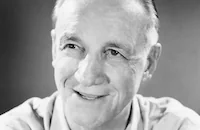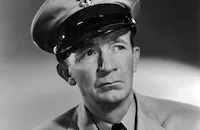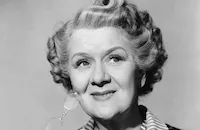The Wild Blue Yonder
Cast & Crew
Allan Dwan
Wendell Corey
Vera Ralston
Forrest Tucker
Phil Harris
Walter Brennan
Film Details
Technical Specs

Synopsis
In 1943, Capt. Harold "Cal" Calvert is sent to Smoky Hill, Kansas, with other seasoned Air Force pilots, to train on a new kind of aircraft, the Boeing B-29 Superfortress. Running the training program is Cal's cousin, Tom West, a self-effacing engineer, who, Cal is surprised to hear, has been promoted to major. During the first few weeks of rigorous training, the pilots learn that the B-29 can fly higher, faster and longer than the B-24s currently in use, and can carry more powerful weapons, but like a sensitive thoroughbred, the new plane needs careful handling. Although Tom is an excellent teacher, with twenty-four successful combat missions to his credit, the men barely hide their resentment of his promotion, as they believe he claimed engine trouble during his last mission, a major bombing raid over the Ploesti oil fields, in order to avoid combat. In the mess hall, a crewman taunts Tom in front of Helen Landers, the nurse Tom is seeing, and Cal, who is attracted to Helen, acts as bouncer. Tom quietly confides to Helen how fond he was of the young crewmen who were with him throughout the twenty-four missions and how hard he took it when two were killed. He explains that the twenty-fifth mission was to be their last together, but halfway to the target, they experienced engine trouble. He tells her that if only his life had been at stake, he would have continued, but because he wanted the young men to go on living, he turned back. Later, during the pilots' trial run on the B-29s, the overconfident Cal disobeys Tom by flying higher than instructed, causing a breach in cabin pressure. One of the men is sucked out of the plane, but saved by the opening of his parachute at the last minute. Tom reprimands Cal for putting the program at risk, as the Air Force brass is closely monitoring the B-29 program and Washington "bigwigs" are questioning its cost. The instruction continues and after several months of grueling training, Maj. Gen. Wolfe, who set up the B-29 program, pronounces the men ready for action. He leads them first to a base in India, where the voice of Tokyo Rose greets them, and then to a Chinese base, where landing strips are "handmade" using the limited equipment and resources available in that area of the world. As the time of their first mission approaches, Tom, struggling with his demons, tells Wolfe the truth about his unsuccessful mission. Wolfe reassigns Tom to design modifications for the B-29s, intimating that he, too, is being replaced. During their first mission, a night raid on Japan, Cal and his men lose one engine. They then narrowly escape the explosion of one of their own bombs when it gets stuck in a bay, before a young crewman, Sgt. Shaker Schucker, dislodges it and sends it on its way. Despite the difficulties, the crew returns triumphantly. Later, both Cal and Tom are transferred to Guam, where Helen, also assigned there, finds that she is falling for Cal. When the area is attacked, she and Tom are injured moving the hospitalized crewmen to safety. Meanwhile, Cal heroically performs many bombing missions, flying at high altitudes mostly out of reach of the Japanese retaliatory shots. However, when Gen. Curtis E. LeMay takes over command, the bombers are ordered to fly lower for more accurate bombing, which makes them more vulnerable to anti-aircraft missiles. Sensing the contempt of the other men, the grounded Tom waits for an opportunity to vindicate himself, but after Helen expresses her admiration of Cal's heroics, he asks to go on one more mission. When Cal leads a squadron of planes, including 452 B-29s, to Tokyo, Tom is assigned to accompany him. Their plane is hit by Japanese flak, and Cal and several others are wounded. Taking over the plane, Tom completes the mission with the damaged aircraft, but is forced to crash land. On the ground, Cal and the other men are evacuated, but when Tom returns to the plane to pull out a panicked crewman, he is killed in the explosion. Several weeks later, the war ends, and Cal and Helen remain together.

Director

Allan Dwan
Cast

Wendell Corey
Vera Ralston

Forrest Tucker

Phil Harris

Walter Brennan

William Ching

Ruth Donnelly

Harry Carey Jr.

Penny Edwards

Wally Cassell
James Brown
Richard Erdman

Phillip Pine

Martin Kilburn
Hal Baylor
Joe Brown Jr.

Jack Kelly
Bob Beban
Peter Coe
Hall Bartlett
William Witney
David Sharpe
Paul Livermore
Jay Silverheels

Glen Vernon
Joel Allen
Don Garner
Gayle Kellogg
Gil Herman
Reed Hadley
Freeman Lusk
Richard Avonde
Robert Karnes

Kathleen Freeman
Jim Leighton
Ray Hyke
John Hart
Paul Mcguire
Robert Kent
Amy Iwanabe
Andy Brennan
Bob Morgan
Steve Wayne
Stann Holbrook
Jack Sherman
Myron Healey
Crew
John Bourke
Robert Crawford
Allan Dwan
Allan Dwan
Andrew Geer
Peggy Gray
Charles Grayson
Charles R. Green
Kenny Holmes
Reggie Lanning
Howard Lydecker
Theodore Lydecker
Bob Mark
Lt. Col. Ira V. Mathews U.s.a.f.
John Mccarthy Jr.
Richard Moder
Adele Palmer
James Sullivan
Ellis F. Thackery
Charles Thompson
Richard Tregaskis
Dick Tyler
Richard Van Enger
Ned Washington
Howard Wilson
Herbert J. Yates
Victor Young
Victor Young

Film Details
Technical Specs

Quotes
Trivia
Notes
The working title of this film was Wings Across the Pacific. The opening title card reads: "The Wild Blue Yonder, The Story of the B-29 Superfortress." A written prologue thanks the men and women of the United States Air Force, the Marine Corps and the Department of Defense for their assistance and participation. Voice-over narration, spoken by Wendell Corey as "Capt. Harold Calvert," is heard intermittently throughout the film. A February 1951 Hollywood Reporter news item announced that Sterling Hayden had been cast as one of the leads, but he did not appear in the final film. The Wild Blue Yonder marked the first time that Terry Kilburn, a child actor of the 1930s and 1940s, appeared under the name Martin Kilburn. "The Thing," as sung in the film by Phil Harris, was a hit song in 1951.
As depicted in The Wild Blue Yonder, during World War II, in response to the U.S. War Department's request for a long-range bomber that could carry a heavier payload for longer distances, the Boeing Company designed the B-29. Being the first aircraft capable of reaching Japan from available airbases while carrying 20,000 pounds of bomb payload, B-29s were used in a strategic bombing effort against that country beginning in June 1944. After bases were built in the Mariana Islands, sustained air attacks were conducted during the night from 9 March through June 15, 1945, targeting urban industrial areas of Japan. Two B-29s, the Enola Gay and the Bockscar, dropped atomic bombs on Hiroshima and Nagasaki in August of 1945.
Portions of the film were shot at March Field Air Base and Mojave Airport Marine Base in CA; Davis-Monthan Field in Tucson, AZ; and Walker B29 Air Force Base in Roswell, NM, according to February and March 1951 Hollywood Reporter news items. A modern source states that the aerial scenes of the bombing of Tokyo were filmed above Catalina Island. Brief scenes in the film recreate the raising of the flag at Iwo Jima and Sgt. Henry "Red" Erwin's saving of the aircraft, City of Los Angeles. Erwin was paid a $1,500 "portrayal fee" for the scene, according to a modern source. The same source stated that Republic sought permission to quote Winston Churchill in the prologue of the film, but Churchill declined. The film was re-released in 1958. On September 24, 1951, Wendell Corey, Vera Ralston and Forrest Tucker recreated brief scenes from the picture for a special Lux Radio Theatre broadcast honoring the 50th anniversary of motion pictures.












